The Historical Sew Fortnightly ‘Eastern Influence’ challenge, and my Chinoiserie promenade gown seem like the perfect opportunity to show you my 19th century Chinese ‘cloud collar’ – or what remains of it.
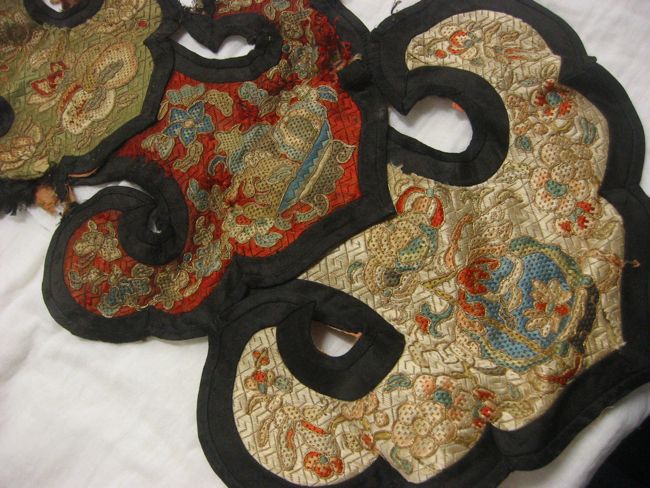
My cloud collar really isn’t a full example – it’s missing one full lobe that would sit on the proper left shoulder, and half of the back lobe, and is quite damaged in other places
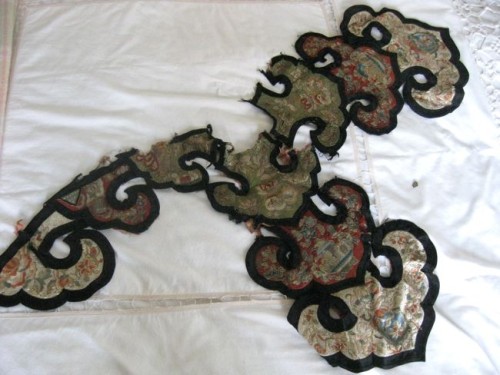
I found the cloud collar in a bin of textile rags at the East Bay Depot for Creative Re-use in 2002 or 2003. At the time, I didn’t know what it was, but I knew that it was Chinese, and I knew that it was old, and I knew that it was interesting, and I knew that at $5, even on a student budget, it was well worth buying!
It’s been carried around in my stash ever since – brought out for talks, and as a study piece for my students. I’ve learned quite a bit about cloud collars in general since, and about the materials and make of my particular collar, but I still wonder how it came to be in the rag bin, and how it came to be in California in the first place.
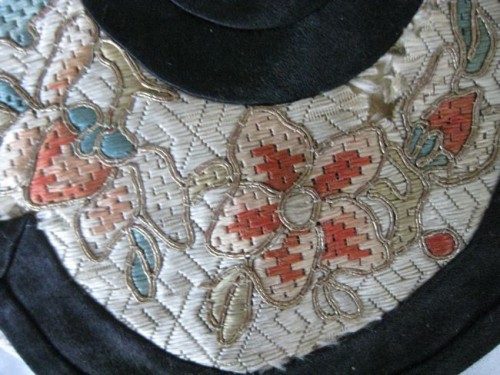
Cloud collars are worn by women for auspicious occasions, particularly for weddings. Was it brought to America by one of the few Chinese brides to be allowed into the US in the 19th century? Was it brought later, in the early 20th century, by one of the many Western collectors who bought up Chinese textiles in great quantities (usually with more enthusiasm than taste). Or was it a quite recent import? And how did it come to be completely discarded?
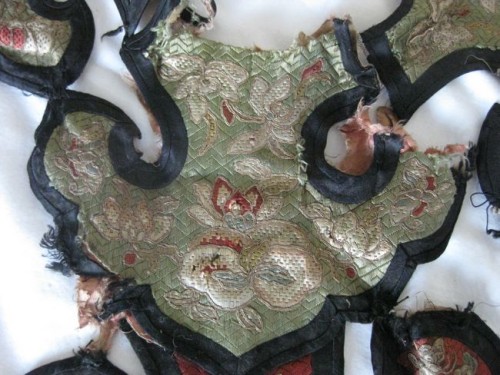
All the motifs on the collar have symbolic meanings, and I believe the different colours of lobes mean different things, so collars with red closest to the face, instead of green like mine, might mean something different.
I know some of the symbolism of the motifs on the collar. The pumpkin in the fruit bowl symbolizes fertility (lots of seeds), and the weird green fruit on the other side of the bowl is a Buddha hand lemon, symbolizing, obviously, the Buddha (and something about immortality and purity etc.). Clearly a suitable garment for a wedding!
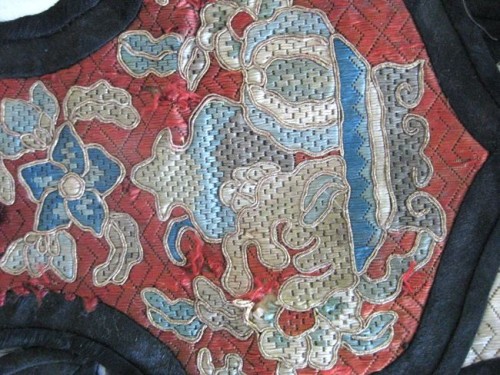
I don’t think my cloud collar was the highest quality example of its type, even when it was new and un-damaged. The pattern is woven, not embroidered, indicating 1) that it was post the introduction of Industrial Revolution weaving machines in the East, and 2) it would have been considerably cheaper to make than a hand-made example would be.
There is hand-applied couching on top of the machine brocading, but the application is quite large and rough. The gold couching isn’t the only gold in the collar. The damage and disintegration has revealed a hidden secret. There is a layer of gold foil between the brocaded outer and the support fabric and backing.
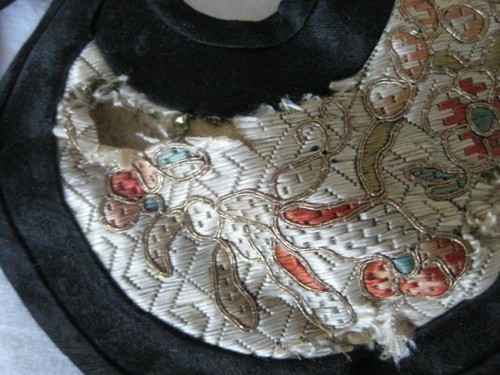
What is the point of the gold foil? We wondered about this for a bit, and then realised the gold might subtly reflect and sparkle in candlelight through the tiny holes in the brocaded outer. Clever!
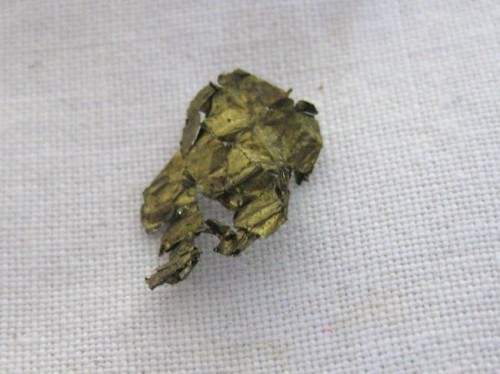
While the gold foil is clever, the backing of the cloud collar also makes me think that it wasn’t the most expensive item. Each different petal of the cloud collar is constructed separately, and then roughly basted together.

The construction almost suggests mass production – make a ton of each petal in each colour, sew them together after the fact, quicker and cheaper.
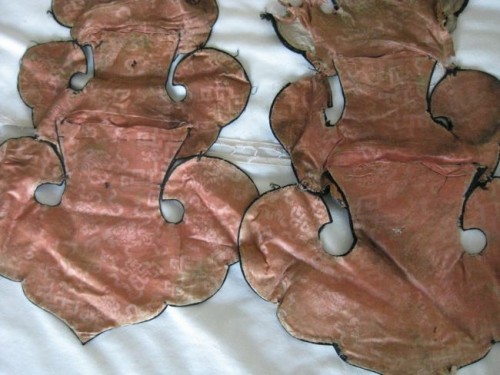
If you’d like to see more examples of Cloud Collars, the Metropolitan Museum of Art has a similar one with one fewer layers of petals, but with fringe. The Textile Museum of Canada has one with the same three layers of petals, in the same colours, as well as a selection of other types.

It’s so fascinating to have such a glimpse into another culture. And these “poor” clothes are always so interesting – e.g. to see what was important for people to have…
Even though it wasn’t the best quality – this would have been far from ‘poor’ clothes. Cloud collars were definitely special occasion wear for the cultural elite, even if they were less-well-off elite. 19th century Chinese society wasn’t big on social mobility, so, just as in say, Regency England, you could be upper class, but still poor. And there was a very obvious division between the clothes of the Manchu ruling class, and the Han commoners (though you could be a poor Manchu or a rich Han).
While never drawn to Eastern cultures (despite 17 years of super duper traditional martial arts), I’d like to be respectful. So it’s to my utter shame that I know little of the ethnic groups that make up the Chinese population and assembled cultures. Thanks for posting about all of this so we can learn.
Okay, thank you for the clarification.
Would this be something that would be owned by an upwardly mobile middle – classer trying to get into the upper classes, or simply something everyone would want to have, as Hana-Marmota suggested?
I think it would have been more something that would have been used by a poor member of the elite classes, or (considering it was in the US) by someone holding on to a culture that they were now separated from, or (least romantically) it was made specifically for the huge trade in Eastern textiles for the Western market, as an ‘authentic’ item, but without the attention to quality that would have been required when it was really being used by the Chinese.
There are literally thousands of ‘authentic’ bound-foot shoes in Western collections and museums that were never worn, nor intended to be worn, but were created specifically for the demands of an outside group which was fascinated with the practice, and could be fooled with less than bona fide items. Lotus shoes were the most common to be mass produced for the outside market, but other textiles were certainly part of the practice, and mine may be an example of that. Sometimes they were even distressed. They are sort of ‘real’ fakes. Not purely ‘real’, but interesting historical artifacts in their own right, because they illustrate the Western fascination with the East (and the timeless ability of tourists to be ripped off).
Ah, the poor upper-classer keeping up appearances certainly makes sense, happened a lot and continues to happen today in some families.
The other ideas are possibilities as well.
Interesting point about the shoes – that might explain why there are so many of them in the Czech National Museum collections! (I searched an online collections site for textiles and was quickly bored by the abundance of those tiny Chinese shoes when I was actually hoping for Czech clothing. :D)
Whether it’s the best example or not, I still think it’s neat! I’ve had a love affair with Eastern culture for the better half of my life now, so this is very interesting to me! Also, I love the meander theme on the background–can it get any better than that?
Happily I don’t feel that being a poor-quality item makes it any less of a good example – 100 years from now cheap K-Mart jeans are actually going to tell a more accurate story of American apparel and consumerism than Nude or whatever the current designer jeans are 😉
Clever you picking up on the meander theme! I’ve used it as inspiration for part of the Chinoserie promenade dress – I hope you like what I’m doing with it!
Oh, was it found while cleaning up an old apartment? Was a new bride given it as a heirloom by an evil mother-in-law and wanted to get rid of it–and her nasty spirit–by throwing it away? Or was it used on a 1920s fancy dress and was bought cheap for that purpose? So many story ideas!
Hehe. I love your theories! The fancy dress one is pretty good – I’ve seen images of 20s fancy dress with people wearing Chinese robes, but not cloud collars, but it is a distinct possibility.
I must do more research on this!